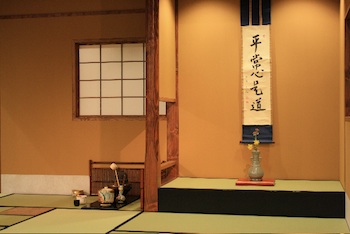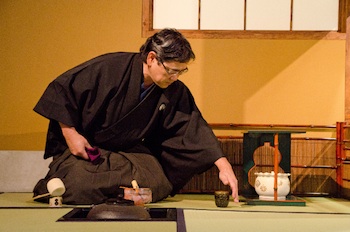
The Chikarukken tea room at Whitman College, Walla Walla, Washington. At right is the tokonoma, a traditional alcove where calligraphy and flower arrangements that enhance the tea experience are displayed.

The Way of Tea at Whitman College
In Japan, a traditional tea room often receives an individual name suggesting something of the simplicity, respect for nature, and mindful attentiveness associated with tea ceremony. In Walla Walla, Washington, Whitman College’s two-year-old Yabunouchi style tea room bears the name Chikurakken or “Enjoying the Bamboo Room”. The source of the name is a calligraphy scroll that reads:
“Bring in some bamboo and enjoy its cool wind and shadows.”
Designed by Professor Akira Takemoto, Chair of Whitman’s Department of Foreign Languages and Literatures, the Chikurakken serves as classroom, art gallery (housing some of the Whitman College Davis Collection of Asian Art), visitor attraction, and tea ceremony space. Professor Takemoto, who has taught at Whitman since 1983, is an ordained priest in the Nishi Hongwanji lineage of Jodo Shinshu Buddhism. A student of the Yabunouchi school of tea since 1976, Takemoto has been authorized to teach it by the current Grand Master, Yabunouchi Jochi.
A rare and reverenced commodity when it entered Japan from China in the late 8th century, tea was prepared and consumed with disciplined formality in Buddhist temples and became the focus of elegant gatherings among the nobility of the Heian court (795-1185) in its capital, Kyoto. Meticulous attention to the design of tea spaces and their decoration, to fine utensils, flower arrangements, costume, and poetry became essential components of the tea aesthetic.
During the Kamakura period (1185-1333) and following centuries, a trend toward simplification arose. The “elegant refinement” (miyabi) of the Heian style was met by the idea of wabi, which placed emphasis on restraint, naturalism, and, ultimately, emptiness. According to Takemoto, “The wabi world invites us to enter tea spaces ‘just as we are’ and to encounter the world ‘just as it is’.” This period also saw innovations in religion in Japan, with the rise of Zen, Pure Land (Jodo Shinshu), and Nichiren traditions.
The Yabunouchi school of tea dates to the 16th century. Its founder, Yabunouchi Kenchu Jochi, trained under the renowned tea master Takeno Joo and had connections to the two other most important tea teachers of the era, Sen no Rikyu and Furuta Oribe. In 1640, Kenchu’s son, by invitation of the abbot of Nishi Hongwanji, took charge of all tea gatherings held at the temple, headquarters of the Jodo Shinshu sect. This role has remained in the Yabunouchi family unbroken for thirteen generations and their close connection with Nishi Hongwanji continues today.

Professor Akira Takemoto demonstrates the art of tea, Chikurakken tea room, Whitman College.
Whitman’s Chikurakken is modeled after the grand tea room located on the grounds of the Yabunouchi residence in Kyoto, adjacent to the Nishi Hongwanji temple. The Kyoto tea room bears the name Shukido, meaning “Hall of Shining Light”. Shukido is where Professor Takemoto began his tea training in 1976 and where he received his formal permission to teach the Yabunouchi style of tea. He returns to Kyoto annually to continue his practice at Shukido.
Like Shukido, the Chikurakken tea room invokes both the austere wabi aesthetic of simplicity and frugality as well as elements of the elegance and vigor introduced by 16th century warrior tea masters such as Oribe. Somewhat smaller than its model, the Chikurakken has a six and a half tatami mat space for preparing and serving tea and a one tatami tokonoma, a traditional alcove where calligraphy and flower arrangements that enhance the tea experience are displayed. Chikurakken”s calligraphy scroll was written by Yabunouchi Jochi, the current grand master of the Yabunouchi tea tradition, and given to Professor Takemoto in 2004. It reads:
“The Ordinary Mind; That is the Way.”
Each tea gathering invites participants to experience fully, mindfully, and calmly all the factors unique to that event. As Professor Takemoto puts it, “Chanoyu, the art of serving and receiving tea has been called a collaborative art form because it requires the skills, the sensibilities, and the athleticism of performers, ceramic artists, calligraphers, poets, architects, flower arrangers, sweets makers, tea shop owners, Buddhist priests, and lacquer, metal, and bamboo utensil makers. But perhaps most of all, it requires the willingness of guests to set aside the time to enjoy how a tea gathering happens.”
In the words of Konnyo Kozui, 22nd Abbot of the Nishi Hongwanji sect of Shin Buddhism:
“The essential truth of the teaching of tea is, entering a state of
contemplative peace, to seek to be active in the midst of calm.
Thus calm activity, activity and calm together, become the teaching of tea.”
“Jodo Shinshu,” explains Professor Takemoto, “remains a tradition firmly settled in the ground of the community (the sangha) where people of all ages bring different energies to a dynamic and complicated gathering place and share life's many challenges. As Gary Synder once wrote, Buddhism is not necessarily only about solitary, meditative, or cerebral contemplative practices, it is what he called the ‘mastering of the 24 hours’.
“The Whitman College campus is very much like a Jodo Shinshu temple where students and faculty participate in a wide variety of activities. The Chikurakken tea room serves as one of many training halls on a campus where students can learn to anticipate, respond, and serve the needs of their friends.
“In tea, the idea of serving and sharing is called motenasu, that is, to bring friends into a context and ‘serve’ them with a different kind of sensory experience. In many ways, it is a way to share the dharma; not by using words or ideas, but by providing an opportunity to experience precious moments.
“The students who do the ‘serving’ practice what it means to clean and prepare the tea room; they look for flowers, boil water, make tea, and clean up. Students and faculty who enter as guests participate in an event that is always ichigo ichie, ‘a gathering that happens only once’. It is a sharing that is always done ‘for the first and last time’.
“For this reason, the Chikurakken remains a unique place that is not divorced from the academic and social life of the college. The Chikurakken, as a vibrant reminder of Jodo Shinshu ideas, exists and finds itself comfortably sitting in a classroom setting, a place where complex, chaotic, and energy-filled discoveries happen.”
For more information or to schedule a visit to the Chikurakken tea room, please contact Whitman College.
Contributors: Akira Takemoto; Julie Welch.
Photos: Courtesy of Whitman College.